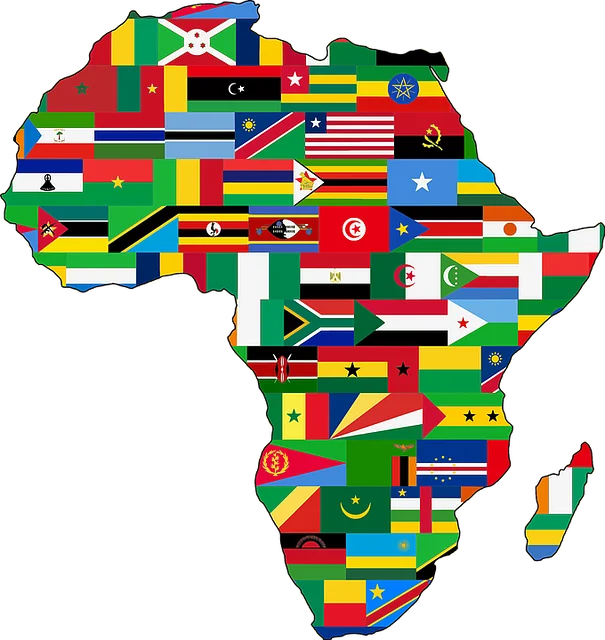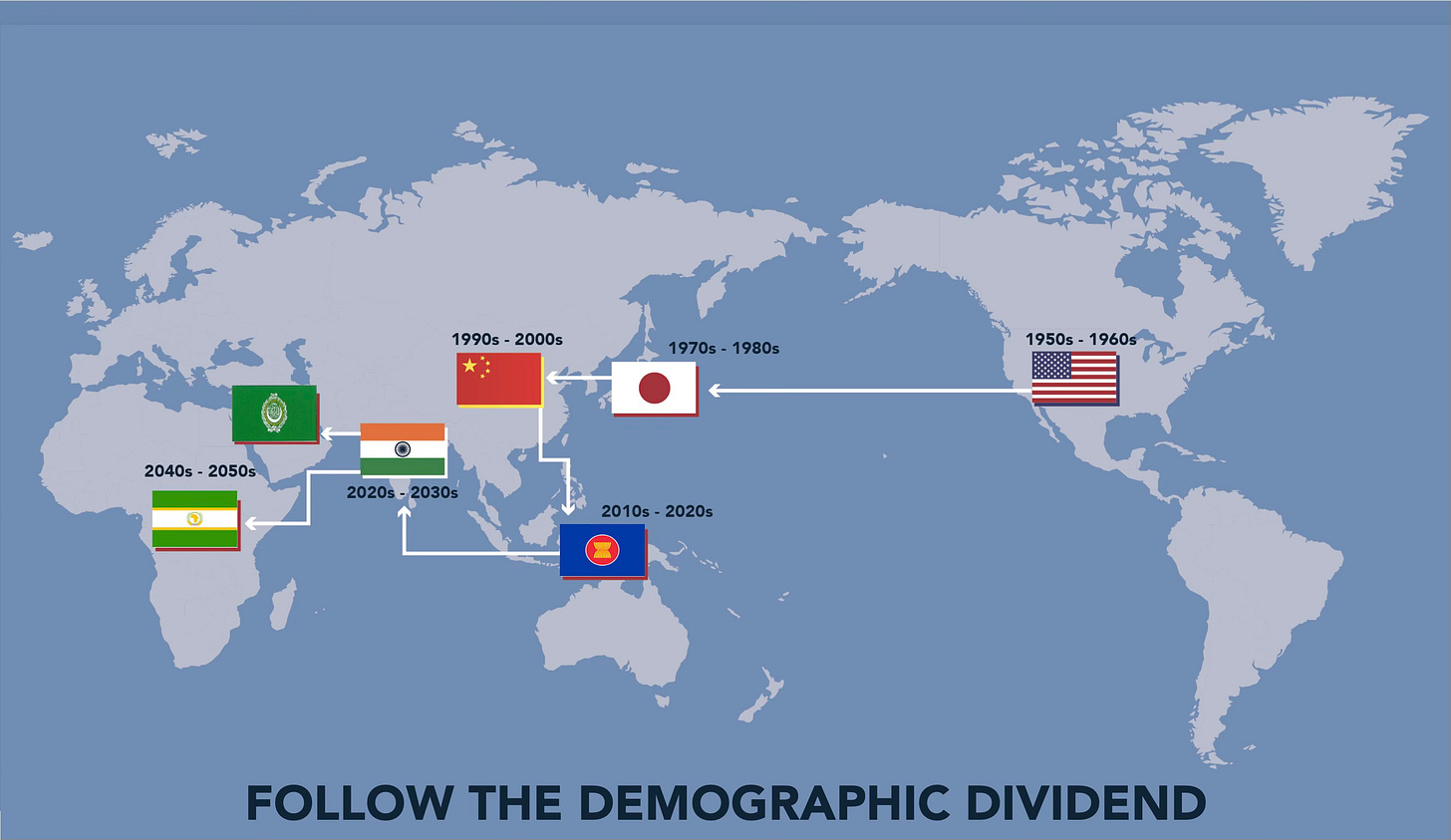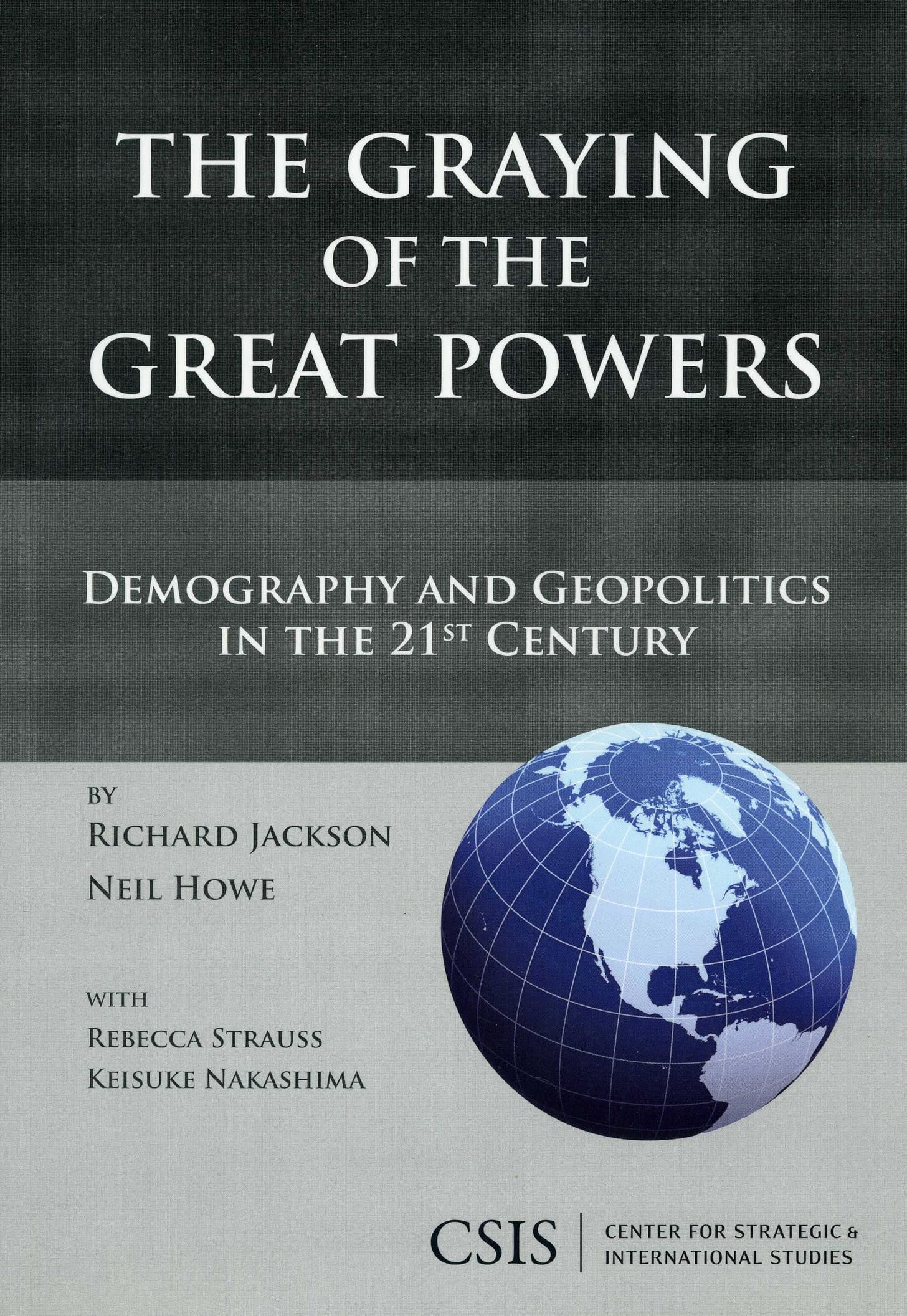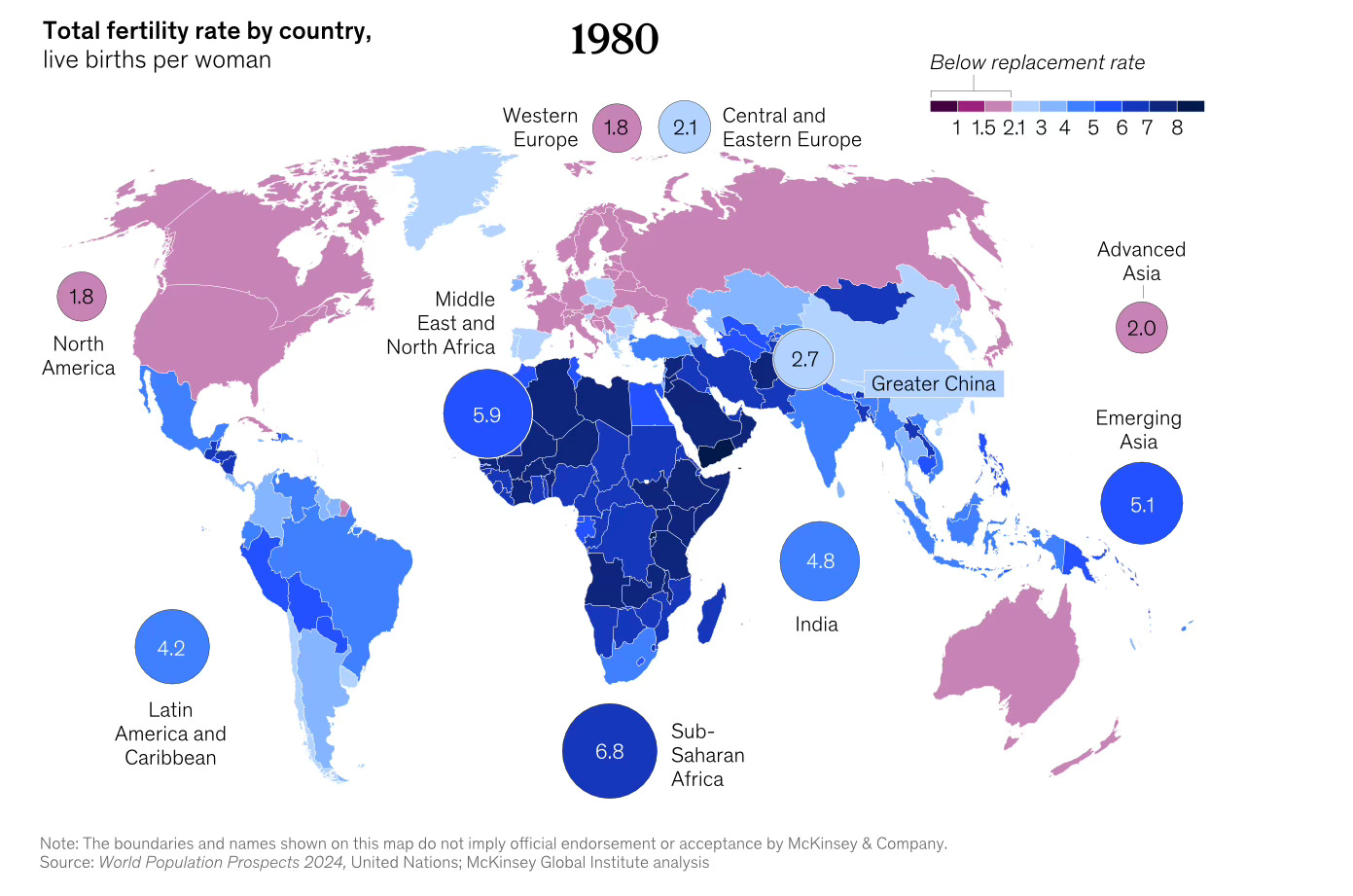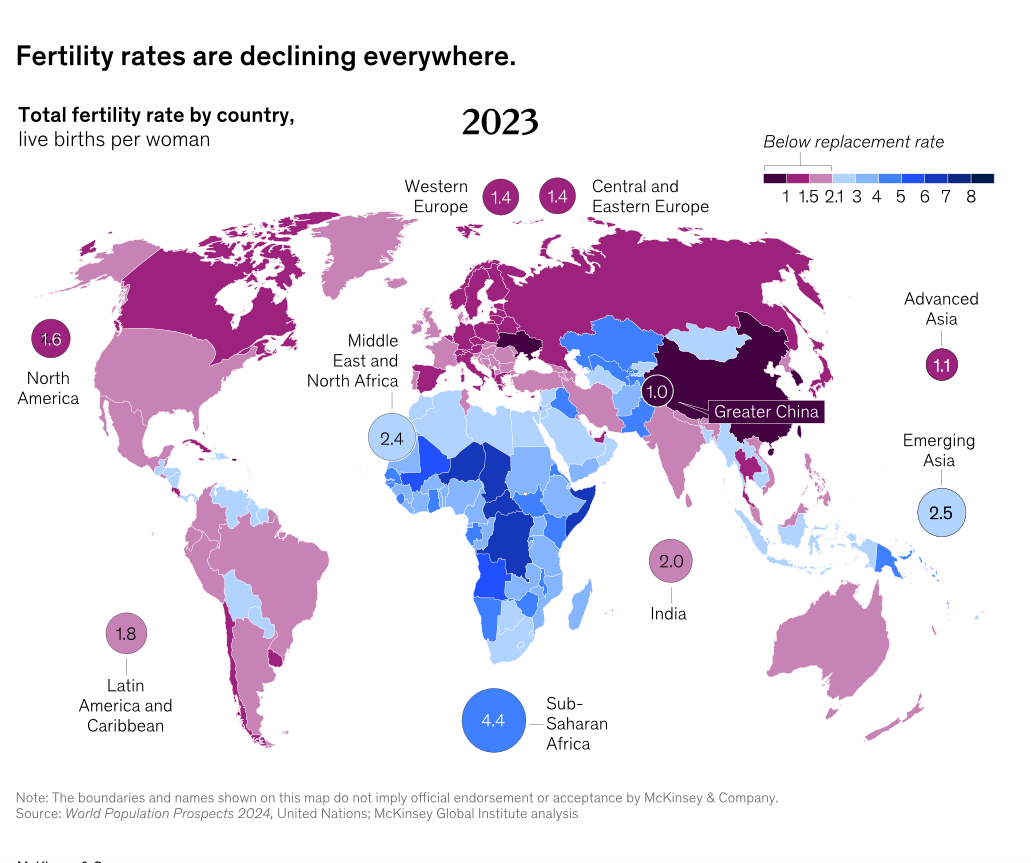[POST] The Coming African Centrality (part 1 of 2)
The continent takes center stage in demographic terms
This is a reader-supported publication. I give it all away for free but could really use your support if you want me to keep doing this.
I developed the below slide approximately 15 years ago, I have been briefing a version of this since then and still brief it today.
I created this “secret history sequence, which I’ve yet to find anywhere else until recently, in response to this 2008 book: The Graying of the Great Powers: Demography and Geopolitics in the 21st Century.
My 2005 book, Blueprint for Action: A Future Worth Creating, was cited in the conclusion:
Adapt weapons, training, and force structure. Demographic trends will influence both the types of locales in which militaries will be called on to fight and the types of missions they will be called on to execute. Warfare will be increasingly urban; nation building will be as important as battlefield victory; and expertise in “exotic” languages and familiarity with foreign cultures will be essential. Weapons, training, and force structure must be adapted accordingly. It may make sense to develop a special nation-building force—or what Thomas Barnett calls a SysAdmin Force.*
*Thomas P. M. Barnett, Blueprint for Action: A Future Worth Creating (New York: Berkley Books, 2005).
Howe, per my memory, later interviewed me for a subsequent book/report of his, but, for the life of me, I can’t remember anything much about it. Howe later went on to pen, with William Strauss, The Fourth Turning, which is some big-time grand narrative stuff (the word destiny appears in the subtitle!)
Anyway, in The Greying of the Great Powers, Howe and Jackson provide these regional aging projections deep into the 21st century, with estimates of when any youth bulge was appearing and being processed. What struck me across the various charts was an unrecognized sequence that I eventually proposed in the slide above.
I briefed this slide for a solid dozen years, receiving zero pushback on the data or the analysis but, less good, with nobody else making a similar argument, which left me feeling like this was something only I “saw” — so maybe not so real, no matter how many times I cite evidence cropping up here or there.
A recent example from this Substack:
Going gray on a global scale
Famed demographer Nicholas Eberstadt weighs in on a key component of my American grand strategy
This is how it is described in America’s New Map:
The popular history of modern globalization unfolds as a series of world-conquering economic models. It begins in the 1950s and 1960s with America’s big-firm capitalism and its unprecedented domination of global manufacturing, segues into Japan’s stunning rise (1970s and 1980s) as a model of state-guided “industrial policy,” and culminates with China’s system-reshaping rise (since 1990) as an authoritarian, state-controlled economy. In each instance, the dominant economy’s reign was predicted to last forever, while the dethroned loser was relegated to history’s economic dustbin …
My secret history of globalization acknowledges those great powers but deterministically describes their rise-and-fall dynamics from a demographic perspective. America escaped World War II demographically and industrially unharmed, only to immediately enjoy a baby boom that allowed it to capitalize on its supremely advantageous position as sole surviving economic superpower. America was indeed great but sought to share that greatness with others, engineering the economic resurrection of former enemies (Japan, Italy, Germany) and encouraging Western Europe’s cloning of its integrating political union (the EU).
Taking advantage of America’s largesse, Japan’s three-decades-long post-war demographic boom fueled its amazing industrial rise while preordaining its rapid aging. Tokyo and its imitators, known as the Four Asian Tigers (South Korea, Singapore, Hong Kong, and Taiwan), were too successful for China to ignore, particularly as the Soviet Union’s rapid dissolution confirmed the economic backwardness of state socialism.
China’s own demographic dividend (1980–2010) followed closely on Japan’s heels, only to peak during the Great Recession. Not only have factory wages risen ever since but now Beijing also faces a loss of 200 million workers by 2050.
Fortunately for China, globalization’s next great pool of cheap labor emerged next door in Southeast Asia, to which Beijing is already directing its lower-end manufacturing assets and investments in increasing competition with Japan and India. But Southeast Asia’s own rapid aging is well underway, compressing its demographic margins and marking it as mere placeholder for its far-larger successor: India, with its youth bulge of half a billion souls. India’s demographic dividend will peak in the 2035–2040 time frame, subsequently yielding to similar dynamics in both the Middle East and Africa, which in combination will offer up a dividend approaching one billion workers.
By following this treasure map, one can track globalization’s center of gravity as it moves over this century, to include its transforming instabilities, rapid urbanization and industrialization, emerging middle-class consumption, out-of-control environmental damage, and fitful democratization. It is also the easiest way to follow the money (foreign direct investment, or FDI).
So, basically, I’ve been selling this “secret history” for just over a decade and a half — again, never to see it replicated or confirmed by anyone else in its geographic sequencing — until this last January, when McKinsey came out with this report (which I briefly touched upon in a February 2025 Sunday Cutdown, citing other data points):
Finally, somebody made a similar demographic-sequencing argument — someone I totally respect (McKinsey Global Institute).
Their version of my “secret history”:
Spelled out in text:
Among first wave regions are predominantly developed economies—Advanced Asia, Central and Eastern Europe, North America, and Western Europe—and Greater China, which has lower GDP per capita than other first wave regions but shares their demographic characteristics. These regions have an average total fertility rate of 1.2 children per woman today, and 67 percent of their combined population is working age, down from a high of 70 percent in 2010 (Exhibit 4). In aggregate, this cohort is rapidly shrinking in these regions, where the share of the working-age population is projected to drop to about 59 percent by 2050.
There are two later wave groups of regions. A second wave has just reached the shores of Emerging Asia, India, Latin America and the Caribbean, and the Middle East and North Africa. Their total fertility rate is 2.2, and 67 percent of their population is working age today. This wave is still gathering momentum, however, and will peak in the 2030s in aggregate.
In Sub-Saharan Africa, the average fertility rate is 4.4 today, and just 56 percent of the population is working age. This share will continue to grow, peaking at 66 percent well into the second half of the century, when the third wave of the demographic shift hits its shores.
Basically, McKinsey’s three waves correspond to my Old Core, New Core, and Gap categories from The Pentagon’s New Map.
Not a perfect match-up, and, frankly, I think my chart is better and more discrete and more accurate — if, admittedly, far less data-explicit.
For example, overlay China’s Belt and Road Corridors and they match up nicely with the flow of my “secret history” — a general East-to-West-and-South vectoring from Asia toward Europe, the Middle East, and Africa.
Enough bragging. It’s just good to be validated after all these years.
Doing a far deeper dive this time around, let me say that the McKinsey story speaks big-time to our current obsession with demographic collapse triggered by a birth dearth.
It’s been a long time coming …
This is the world I grew up in, with the US still above the replacement rate and I the 7th of 9 kids in my family (7 surviving still).
Add the pill and women’s liberation in the advanced world and already — just 15 years later — the West and the USSR are both below 2.1.
Jump ahead to modern globalization and you start to get an image not unlike my Core/Gap map.
Pretty good match, ja?
Here, the analysis is brilliant, showing that it’s the decline in fertility that drives the bulk of the decline in population size. People living longer gets you so much, but people having far fewer babies? That moves you along the demographic transition far more deterministically.
As I noted in that previous review of this report back in February, my demographic transition now argues for the following (these slides coming from my Massive Open Online course):
The earliest transition is from the traditional age pyramid to the youth-buldged obelisk.
Then it the obelisk to the desired diamond (serious demographic dividend).
Then it’s the diamond to the bulb and the elder surplus kicks in, and finally it’s the bulb to the inverted pyramid or what I call the “spinning top.”
My full-up sequence is thus: PYRAMID to OBELISK to DIAMOND to BULB to (SPINNING) TOP:
Pyramid is the starting point (and norm for most of history), as in, bottom heavy with kids and/or liftoff for a Baby Boom
Obelisk is the Youth Bulge working its way “up” in age
Diamond is the Demographic Dividend
Bulb is the Super-Aging effect that follows the completion of the dividend
Spinning Top is when you’re truly swamped by the Silver Tsunami.
This is what scares advanced economies: as they age, there’s fewer and fewer workers to support dependents. Right now the global dependency ratio is 6.5 workers for every dependent.
That drops globally to four-per-dependent come 2050, with advanced “first wave” countries dropping the most precipitously and China in particular dropping at world-class speed (which is what earns China “first wave” status even though it’s really a second-wave economy that’s now so rapidly aging that it’s jumped up into the first-wave category in terms of demographic collapse).
When I say that the future of globalization is mostly non-White, non-American, non-European, and non-Western … this is what I mean.
Think about it: one-out-of-three humans in the world in 2100 living in Sub-Saharan Africa alone!
I’ll tell you that’ll never happen — and why — in Part II of this analysis.
Still, no doubt about the future center of gravity of global youth culture: it will be Africa.
Last scary point to consider: older households in America represent only 20% of the population but over 40% of the wealth. The bulk of that wealth is found in real estate (almost 60%).
Layer climate change on top of that asset pool, making it essentially uninsurable, and we all need to become far more worried about the future of our national economy as we further age.




